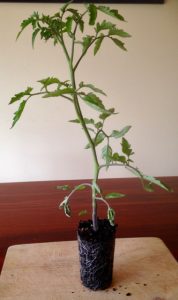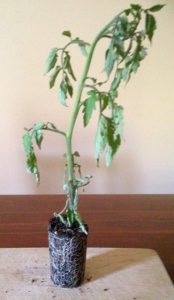The art of watering
Robin Gale-Baker, from Sustainable Macleod tells you all you need to know about watering. This is one of a series of articles she has written about growing techniques (see right hand sidebar). She has also written a number of articles about growing various vegetables, herbs and fruit trees.
Imagine for a moment that you are parched with thirst. Would a teaspoon of water quench that thirst? Or a tablespoon? Or would you need at least a full glass? Chances are that it will be the latter and yet often we do not apply the same principle to plants – especially edible plants. Under-watering can be as detrimental as over-watering. A plant, like us, needs to be adequately hydrated to stay alive but also it needs to be hydrated so it can transport nutrients (particularly calcium) to the whole of its being, and to thrive sufficiently to produce the edible parts: leaves and stems, fruit and flowers, roots and seeds. Here are some tips on what to watch out for.
Hose, nozzle and tap fittings
It is worth purchasing a good quality hose and trigger nozzle AND good quality tap attachments both for water efficiency – no leaks – and for being able to deliver water at the correct and appropriate strength. A nozzle with an extended arm and a head that can be adjusted up and down and a range of capacities such as stream, soak, shower, spray and mist is ideal. These settings are very useful as they fulfil different functions. For example using a fine spray on a punnet of seeds prevents the seeds being ‘shot’ out of the punnet but using this on a tray of 7cm tubes of well developed tomatoes would mean that the water lands only on the leaves and the soil in the pot does not receive adequate or sometimes any water. On the good quality nozzles, there will be an adjuster that fans from low water pressure to high pressure so you need also to adjust this to whatever you are watering. Some plants, such a basil, have quite fragile stems and these can be split or broken by pressure that is too high. The reason for having good quality tap attachments is that poor quality ones with good quality nozzles often leak especially if the nozzle can tolerate high water pressure and the fitting cannot.
Edible plants in pots and punnets
- Always watch what you are doing and ask yourself where did that water go? On to the leaves, into the soil, onto the path? Did I give the plants at the back or front or to the sides an even amount? Are any of them in a draft or next to a glass or plastic surface that will heat them up quicker than those in the middle of a greenhouse? If so they will need extra water.
- Make sure you water the entire soil surface. Say you are growing some seedlings in a large pot or polystyrene box, look down at the edge closest to your feet and make sure that that edge is as watered as the back edge. Often we don’t water what we don’t see. Water right to the edges. If you don’t do this, the soil will dry out, shrink away from the edge and then water will run straight down the sides of the pot and out the bottom. And if the whole pot is not evenly watered the drier soil on the edges will draw water from the middle.
- As a plant grows bigger its need for water will increase even if the temperature stays constant. This is for 2 reasons – first because there is more of it, and secondly because as the root ball expands, it ‘chews’ up the soil and over time the pot becomes lighter as there is more root and less soil. This means that there is less soil to hold the water and it will dry out more quickly. Either the plant needs to be planted out in the ground at this point or potted into a larger pot with fresh potting mix.
- Potting mix itself is designed to be well draining and provide good aeration. By its nature, it is not going to retain a lot of water. Its purpose is to allow good, rapid root development and nutrition uptake, and will keep the plant hydrated for a relative short time in hot weather – say 24 hours if you are lucky. Take this into account and plant out into the ground as early as practical. If you need to keep your plants in pots or boxes, consider the surface they are placed on – brick paving for example will heat up much more than soil. You could also stand your plants in shallow saucers or trays of water in the hot weather, and move them to a shaded area.
- Consider also the material your pot or box is made from. Terracotta itself absorbs water so less is available for the plant if your pot is terracotta as opposed to plastic. Polystrene heats up less than either. If you are using peat blocks or coconut coir pots you will need to keep them moist at all times. Coconut coir or vermiculite can be a useful addition to potting mix, giving it more ability to retain moisture. Make sure coconut coir is thoroughly soaked before adding it to your potting mix and sprinkle vermiculite through your bag of potting mix turning it right through evenly then dampen it, before placing it in your pots.
- Experiment with your pot plants by weighing them when dry, then when watered. There will be a considerable difference. Often just lifting a pot in your hand, will tell you it requires water because of its lightness. You could weigh your dry pot, then add several fluid ounces, then more and so on till you get a good sense of what a watered pot weighs and how much that looks like in a measuring jug.
Edible plants in the garden (excluding wicking beds)
- For 7 months of the year in Melbourne, most fruit trees, vines and vegetables will survive well enough on rainfall. It is important to start watering, generally in November, to capitalise on this and prevent the ground drying out before setting out on a watering regime for summer. These days watering needs to cover November through to the end of April.
- Deep watering 2 -3 times a week is preferable to shallow watering daily. In fact people who have accidentally flooded their fruit trees and vegetable beds by leaving the hose on overnight, report that they have had tremendous cropping as a result. In our area the subsoil is clay and this, once saturated, retains water which then acts as a reserve, especially for fruit trees with their deeper root systems. If however clay dries out it is very hard to re-hydrate.
- Concentrate plants in particular areas and with particular watering requirements to save water.
- Use mulch around trees and vegetables making sure the ground beneath the mulch is moist before laying it and continues that way.
- Use shade cloth to cover vegetables and vines in high heat. A simple way is to knock 4 star pickets into the corners of a garden bed, drape with the shade cloth and push yellow star picket caps down over the shade cloth corners and onto the pickets. Otherwise drape the cloth or old sheets over the plants and hope the wind won’t below them off. Or even put up a beach umbrella!
- Check when you water that the earth is really moist beneath the surface. Use a trowel and dig down to see whether water is penetrating. Once the soil becomes hydrophobic, it is really hard to saturate. Water will ‘bead’ and roll around but not penetrate. At this point it will need not only a lot of water but digging over of the soil to mix it with the water. The more organic material in the soil the easier this will be. If you face this problem, one solution is to add more organic matter.
- Check where your water is going. Don’t wiggle the hose around or make figure 8’s with the stream. Focus the water where you want it – around the trunk or stem and out to the drip line (the furthest extent of the foliage) and give it enough.
- Dig a shallow moat around a plant so that the water has a channel to fill and sink through to the outer roots. This also works well on slopes to prevent water run off.
- Water straight onto the ground. Avoid overhead watering of vegetables in summer as this leads to mildew.
- Water in the early mornings if at all possible as this will keep your plants hydrated during the day and the foliage will be dry in the evening and less likely to develop mildew.
- Install a timed irrigation system but check for how long it needs to run and check constantly that it is working!
Remember: a hydrated plant is a healthy plant and will not scorch or wilt in hot weather!

 The left hand tomato is one I let dry out and wilt for the purposes of demonstrating the amount of water required to fully hydrate this plant. Dried out it weighed 182 grams. Just lifting it would indicate it needs water because it would be like lifting a feather. I gave it 50ml of water and one hour later it looked normal and weighed 210 grams. I then gave it another 100ml of water standing it in a bowl and it absorbed most of that in another hour, and weighed 266 grams. Finally I gave it another 50ml and most of that drained into the bowl but not before increasing its weight to 283 grams. So in essence watering the tomato increased its weight by 101 grams, and all this is water, and it absorbed approximately 160ml of water. This is the equivalent of just over 3/4 of a cup. Look at the colour of the roots in both pictures. The first one shows a mass of very white roots, evident because of the dryness of the potting mix while in the second, the soil is well hydrated and as a result the roots can barely be seen.
The left hand tomato is one I let dry out and wilt for the purposes of demonstrating the amount of water required to fully hydrate this plant. Dried out it weighed 182 grams. Just lifting it would indicate it needs water because it would be like lifting a feather. I gave it 50ml of water and one hour later it looked normal and weighed 210 grams. I then gave it another 100ml of water standing it in a bowl and it absorbed most of that in another hour, and weighed 266 grams. Finally I gave it another 50ml and most of that drained into the bowl but not before increasing its weight to 283 grams. So in essence watering the tomato increased its weight by 101 grams, and all this is water, and it absorbed approximately 160ml of water. This is the equivalent of just over 3/4 of a cup. Look at the colour of the roots in both pictures. The first one shows a mass of very white roots, evident because of the dryness of the potting mix while in the second, the soil is well hydrated and as a result the roots can barely be seen.

Thank you. I have my soaker hoses set for the evenings, I’ll change them today so that they come on in the mornings. I’m guessing I should also do this for the fernery sprinklers?
I don’t think that it matters much.
Great! Thank you Robin!